by Zachary Clemente
On the questionably damp morning of the last day of ECCC ’15, I caught up with Image creator Nate Simpson in a small breakfast place called The Crumpet Shop in Downtown Seattle’s world famous Pike Place market to talk about the second issue of Nonplayer, close enough to taste. The conversation spans his interest in narrative art, AI, and a discussion on creating comics in an rapidly gestating environment. Simpson is known for his work on Nonplayer, the first issue of which was release April, 2011. He lives in Seattle with his wife and young child and while he’s not working on game art, he wakes up at 3AM daily to turn out comics pages.
Nonplayer #2 is out from Image Comics on June 3rd.
[You’re joining us after a brief introduction.]
Comics Beat: Well, how about you? How did you get into comics?
Nate Simpson: Well, it was the X-Men; the late Chris Claremont era – Jim Lee, Marc Silvestri, and all that. Actually, right when I started getting out of comics was when all those guys were jumping ship to Image. Then I went off the college in ’93 and I didn’t really have much of an exposure to independent comics until art school six or seven years later.
CB: So you went to college then attended art school years later?
NS: Yeah, I went to college and totally got out of touch with comics completely. I went to the University of Chicago for Paleontology; there were not people reading comics, it was just not happening. After three years studying I realized I didn’t want to be a paleontologist – I just liked drawing dinosaurs. So I switched over to the Art Institute of Chicago…and that was just after Chris Ware had left. There was an indie comics culture there and I got into stuff like John Porcellino’s King Kat – that sort of stuff. From there I slowly worked my way back into comics through the indie angle, but I never really took it seriously as a career path until many, many years later. I fell into game art pretty much right out of art school and if you’re looking at it from a purely utilitarian standpoint – for an artist – there’s really no better game in town. It pays way better and it’s way more forgiving from a scheduling standpoint.
CB: There may be less pitching involved?
NS: Yeah, not at my level. So yeah, game art was going to be life until I came across this book of storyboards for Miyazaki movies – have you seen his original storyboards for Nausicaä?
CB: Oh, yeah.
NS: Dude, that shit melted my brain. It just the one guy working by himself with such a comprehensive vision and the final product was so similar to what his original vision was like.
CB: Did you see the documentary about him – The Kingdom of Dreams and Madness? It was filmed during the production of The Wind Rises and showed a lot of his storyboarding process. He uses a stopwatch while boarding to set the time of shots from the outset, so as each scene was set – he knew how long it would be. What’s really crazy is that the studio launches into production when he’s only half-way done with the script.
NS: That’s how assured he is – there’s no way to go back!
CB: That’s a really interesting place to come from, in my mind. When you mentioned that it was the Claremont X-Men and Liefeld posse were your earlier comic interested – I was going to say I don’t necessarily see those influences in your current work.
NS: Well, the one thing we overlooked is that is that I also had a major Moebius fetish. I think stylistically that’s more of where I’m coming from.
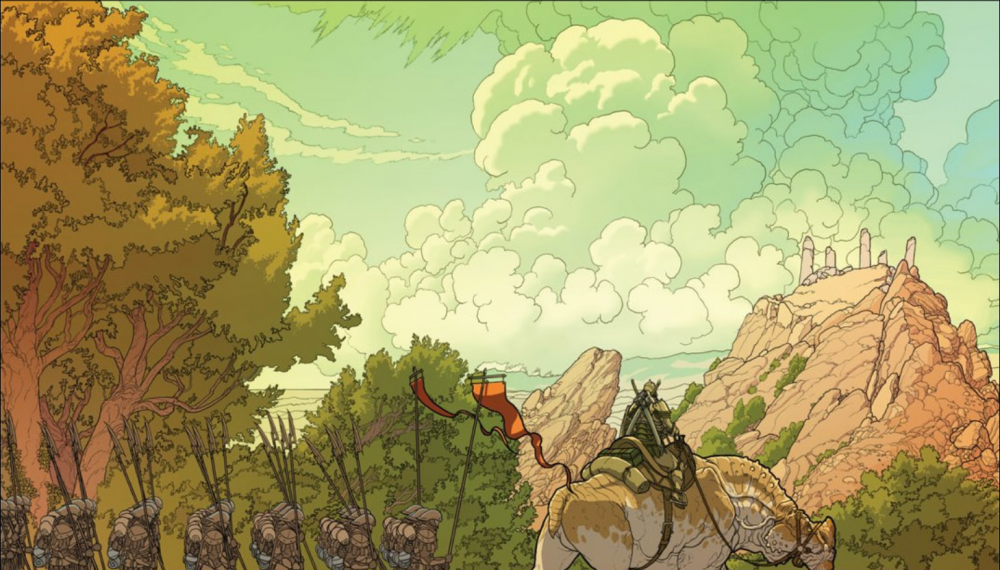
CB: That makes sense. I remember when I first saw the promo art featuring Elloden I thought that it looked very [Geof] Darrow – who’s a contemporary of Moebius.
NS: Oh yeah. I bought all three of the Hard Boiled issue when they came out, and they released like every year and a half – and I was so angry at him!
[Both Laugh]
NS: It’s so ironic. I was saying “what kind of asshole takes a year and a half?”
CB: These names remind me of an interview with Paul Pope I did right when the first volume of Battling Boy had come out where I asked him what he was reading. He said he was staying in his “fortress of influence” which was essentially Moebius, Toth, and Miyazaki.
It really excites me that as Western comics really finds its footing with its Eastern – mainly manga – influences, Miyazaki is beyond that. People were looking to him long ago, even though he hasn’t made a new comic in some time.
Getting back to it – would you say the Miyazaki influence is one of production or also stylistic?
NS: I would definitely say both, but it’s so hard to parse what part of each person you’re taking because it’s a very organic process. However, I was inspired in the wrong way by those storyboards because what I wanted to do was exactly that: make storyboards for a movie.
So the first thing I did was quit my job, which required a huge amount of patience from my wife who didn’t have a job at the time. We were just living off of savings as I was saying “I’m gonna express myself!”
It was a weird six or seven months of writing this screenplay and doing some storyboards for this big, grand, epic sci-fi space opera called “Gordon and the Star-Eater” and it was…horrible. It was the worst.
CB: Sounds like something I’d read.
NS: So after those six or seven months, I stepped back from the screenplay, read it again and went “this is complete shit.” I had wasted more than half a year, we’re out of money, and I had to figure out how to salvage this – make it worth leaving my job. I got super despondent about it and wrote about it on my blog; about how I was feeling lost. Although only three friends really read my blog, one of whom was a co-worker named Ray – who’s gone on to do concept art on Skyrim – told me to just draw a comic.
At the time I naively thought it was the simpler thing to do, rather than a screenplay and storyboard for a movie.
CB: And in many ways, it is. You don’t need cameras or intensely expensive equipment and software or a crew or anything like that.
NB: Exactly. It was very self-contained. I didn’t have to pitch it to anybody; I just had to do it and either it’s good or it’s not – it is what it is. I don’t know if you have something like this, but the “Star-Eater” project is something I’d been thinking about for around 15 years prior. I knew all the scenes, I knew everything that had to happen. It was so set in stone that there was no way for anything to mutate or grow; it was not a creative enterprise at all.
CB: That sounds like a dangerous thing to enter into.
NS: It really is. There was nothing there with that project; it was dead…it was taxidermied.
So that moment when Ray told me to do a comic I got, for the first time in many years, a blank slate to ask myself what I should do – and the story for Nonplayer came on the same day, all at once. “Here’s the stuff I’m interested in now and here’s the stuff I would have been writing about it wasn’t creatively constipated because of this other project.”
Writing out the script for Nonplayer happened really fast; the first two issues were written out in two weeks…and then it’s taken fucking five years to draw them.
CB: Something I’m curious about is your editing process. Given that much time between original script and final product, how many iterations or changes or evolutions have they gone through?
NS: Oh you have no idea; so many revisions. I save every iteration of the book. Some of the individual pages have up to 40 or 50 different versions from the very roughest thumbnail all the way [to final touches]. I’ve even made animated gifs of the process and it’s really cool to see stuff shift around, but the dialogue in changing with the art is changing and in some cases, entire scenes are added or removed – it’s a pretty fluid process.
That’s the great freedom and the great pitfall of working digitally is that you can continue to edit all the way through the process and what’s what I do: just keep polishing and polishing. If I were working in analog media, I would have erased through the page nine times, but there’s not common sense stopping point and that’s a long road that can really eat up your time.
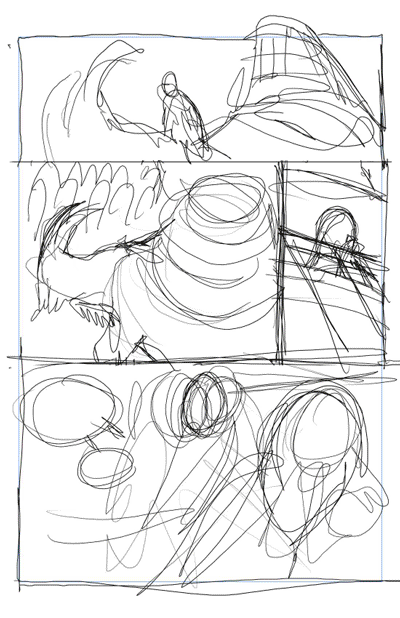
CB: Would you say that the fact that you’re working digitally is enabling in that sense?
NS: Oh, absolutely. Here’s the thing though: without these tools […] I’ve been an adult for about 15 years before starting on Nonplayer and the thing that changed in my life that was enabling for Nonplayer to happen was the invention of the Cintiq.
I had tried to draw comics in pen and ink before and I found it so confining and difficult because I’d have second thoughts or would want to change something – it would drive me crazy. It was upsetting that I didn’t have the freedom to continuously modify. If I had been born 50 years earlier, I never would have attempted a comic, I would’ve lived and died having done some other thing.
CB: Proto game art?
NS: Yeah, maybe. I don’t know – I would’ve dug ditches or something. Maybe I would’ve been a paleontologist or a painter or something.
It’s sort of interesting, my training is in painting and drawing; there was a lot of oil painting. Once nice thing about that is that you keep working it – they even encourage you. I mean, some of those teachers work on one painting for 10-15 years; there’s not a time limit on a painting, you can build the paint out a foot deep if you want to. But that’s never really worked for comics, unless you’re doing painterly comics.
Comics as a pop medium is not an additive one; you need to have the idea and you need to get it out as cleanly and as quickly as you can; but these digital tools […] you have a clean end product but you work in a more painterly way, ironically. I sometimes redraw a line up to 50 times to get it just the way I want it!
CB: It’s so much easier to do that when you’re able to. It’s fascinating to think that we’ve hit a point technologically where it’s potentially as easy to edit the pages as it is to edit the script.
NS: That’s absolutely true. But here’s the other interesting thing: I think we’re in a weird time-gap where people who were trained to use analog materials, like me, have gotten access to these weird digital tools – so there’s a combination of ability and tools. But I notice that younger artists seem much more comfortable working quickly and iteratively – they just use the tools better than I do and they’re much faster than I am.
CB: While a bit reductive and not wholly true, something I do notice is a lot of artist I would consider your contemporaries only use digital for certain stages, like just for color and flatting or inking and up. But if you look at the “Tumblr generation” of artists, you see a swathe of amazing color sketches that were digital from the ground up and that’s all they work in. Sometimes you’ll see some of their analog work, but they’ve figured out how to fine tune the digital tools to fit their style that it becomes very cohesive.
NS: The end product is such a result of the tools, there’s no way to do what they do in any other way, whereas what I’m doing is kind of replicating what comics look like back when Moebius was doing them in the ‘70s. A better artist could do what I’m doing now digitally in an analog form. What I’m doing is “hacking my way” toward a finished product that has that level of polish, but I’m doing it sort of the hard way.
CB: Isn’t that the human condition?
NS: Yeah maybe – we’re all trying to rebuild what we saw when we were 13.
CB: That’s creation and memory. I’m fascinated by the idea of what it means to take something from here [motions to temple] and put it somewhere so other people can see it and how do your tools and the “you” of that time affect, muddle, or change the product. With digital, the opportunity is there to be as clear as possible is there, but it’s the tool could enable some distance or change from the original concept.
Reminds me of Nick Drogotta who, up until issue 15 of East of West was working exclusively digital, but people kept asking for original pages so he switched to penciling on paper to accommodate.
NS: Yeah, and there are guys who do the opposite too, right? There are guys who pencil digitally, then ink on printed out pages. I guess you could do it either way.
Do you know who William Stout is?
CB: No, I do not.
NS: He’s an artist who was predominate in the ’70s – I think he did a bunch of Conan stuff and also a bunch of dinosaur drawings that I got super obsessed with. But seeing his work in person, which I have a couple times, he’s the example the resonated the most for me. There’s something about seeing it on the page; the way that the inks and watercolor […] it was like looking at a jewel. I’d seen them in reproduction and thought they were beautiful but seeing them in real life I understood. It has to be made that way because the important thing is not the reproduction – the important thing is this real object.
And certainly the ethos behind Nonplayer from the very beginning was the only thing that’s important is the book at the end – everything is aimed in that direction and there’s no “object”. There’s a part of me that really wants to make the object; there’s a part of me that’d love to have the freedom to take a step away from the way I’m doing things with Nonplayer and try a different approach. Maybe on another book or whatever, because those are skills that I have.
That’s another thing that doesn’t get talked about very much; it’s that people see the way that Nonplayer gets made and they think it’s the way I draw – “this is the only way he draws”. They think I’m a slow, meticulous artist who works digitally and nothing else because they’ve never seen anything else that I’ve done. I think there’s a little bit of selection bias or something happening there where the only reason they’ve heard of me is because that was only book I made that caught peoples’ attention. For instance, as a game artist, I have to work very quickly, very iteratively, and very roughly sometimes.
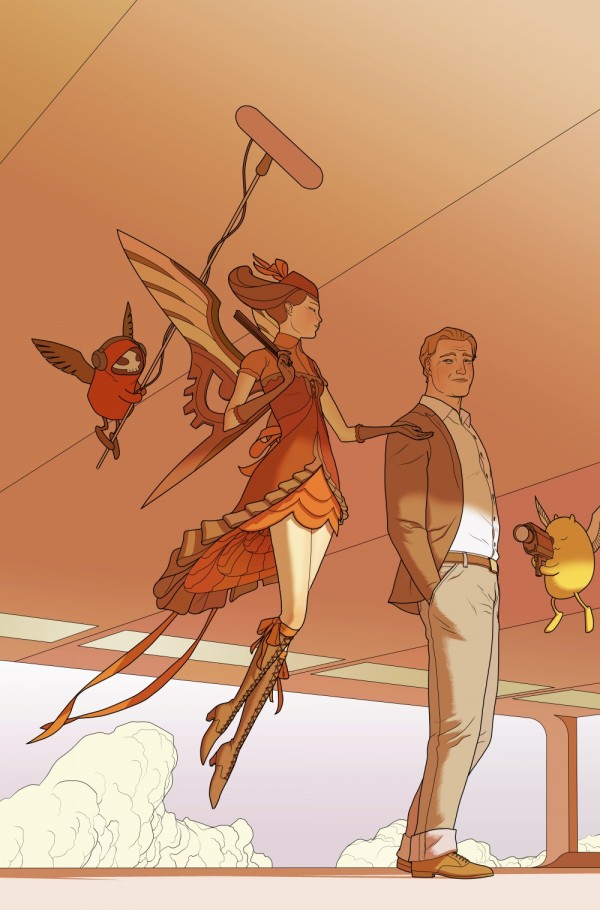
CB: It’s a very small sample to base an opinion off of.
NS: Because that first comic was made at the level of polish it had, all of the others will be have equal to or better than the first one. The second one, by at least some measures, is better. So in a way, I’m locked into that and it’s a pretty rough thing to be locked into. I love working on it, but as an economic proposition, it doesn’t make any sense at all. It doesn’t come close to paying for itself which is why I work on it from the hours of 3AM to 6AM every morning; I have to have a job and a life outside of it.
Sometimes I ask myself if the first comic I had made had been rough, gestural, and quick, it theoretically could have been more financially sustainable, maybe. But would it have gotten anyone’s attention? I might not have, that might not be what people were picking up.
CB: It’s that weird strongly-held belief that artists can only do one style where whatever their working on the time is likely influencing how they draw it. I personally would hazard that most artists at DC and Marvel have the potential for artistic fluidity, but they are working towards specific, recognizable style. Take a look at one of my favorite cartoonists, Boulet – he is able to do so many different kinds of work.
NS: Oh yeah, Moebius was a master of that too, he was all over the place.
CB: Definitely, but his work is always recognizable – I feel he kind of transcended shifts in style.
NS: He was so prolific that if he made something people thought was shitty, the next day he’d make 10 other things.
CB: His speed definitely helped.
NS: This touches on the hot-button topic with issue two coming out; I think there’s a certain amount of…wariness. There’s a certain kind of person who feels like I’ve cheated them in some way and here’s a part of me – a voice inside – that agrees with them. There’s always that little voice inside of me that’s always frustrated with how long this is taking. “Who do I think I am? Who else gets to come out with a #2 four years later and have the temerity to ask people to pay attention to it?” I should be skulking in the darkness, meekly handing it out and scuttle away. But because I’ve put so much time into it, because I’ve been thinking about this for so long, I have no choice but to promote it as hard as I can.
But there are a lot of people who are telling me that everyone else does 12 of these a year and I do 1/48th of one.
CB: I would maybe say that’s a product of, realistically many things but, the oppressive nature of the direct market and the hilarious difference in “creation time” vs “read time”.
NS: We have such a “box office mojo” obsessed culture that we’re having trouble separating the question of comics as an economic engine and a question of comics as a creative pursuit. Making a comic this slowly is a completely losing proposition economically, both for me personally as a creator […] I guess Image makes a little money off of it but it’s barely worth their time. It really doesn’t do much for the retailers – it really doesn’t do much for anybody from a monetary standpoint.
But I’m still doing it in my spare time. It’s getting done. There are gonna be seven of them, two down, 5 to go. I would love to go faster and I would like to find a way to work on this full time and there are some discussion going on about that, but I doubt it’ll ever be financially self-sustaining. It’s just not how it’s gonna go. Does that make it less valid from an artistic standpoint? Assuming this all gets done, assuming I don’t get hit by an asteroid or something, it’ll get done eventually. And when it’s done, it’ll be collected in trade – that big, polished, finished thing – will people factor in the time it took to make it when they make a decision about whether or not they want to buy it? Or, more importantly, when they’re deciding whether or not it’s a good book?
I’m deep in the shit right now, so it’s hard for me to even think that far ahead. I have to remind myself of this every morning at 3AM. “This is worth it because it’s gonna be good in the end.”
CB: That raises an interesting question about the worth of artistic agency. How much is your project “worth” to somebody? I think you’re maybe missing the direction comics can go – for a long time they were driven by the big two, but as other publishers get more of that market share and pushing to have good comics available for every reader possible, you start seeing other shifts.
For instance, Brandon Graham works on a lot of stuff so his solo projects like Multiple Warheads are produced pretty slowly and he shrugs off people giving him flak for it. Of course, he seems to be in a situation where that works for him; having enough going on for it to be okay.
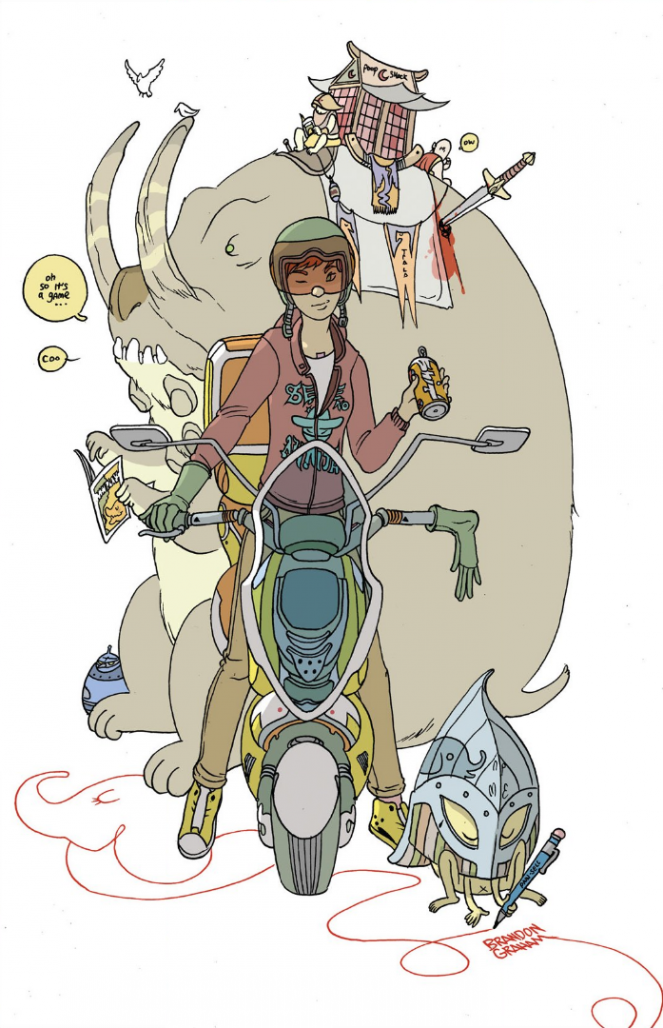
NS: He’s very self-contained, very charismatic, and doesn’t need anybody’s love.
CB: He doesn’t need anyone’s validation, he don’t need no man.
NS: Yeah, exactly. It just occurred to me […] I sometimes feel sorry for myself – as do others – over how I just can’t get all the time I need to be able to work on this all the time, and that would be great if that happened. But, in a weird way, the fact that this comic is not my sole source of income gives me much less freedom on the time axis, but a huge amount of freedom on the quality axis that full-time comics artists don’t have because if next month’s rent depends on you getting this book out the door, that’s going to be controlling your artistic decisions. So in a weird way, I have maximum freedom. Especially with the advances in medicine, I don’t have to worry about dying of old age then, you know, I can just keep this going! So it’s both a blessing and a curse.
CB: Something I’m interested in with Nonplayer, from a storytelling perspective is this idea of the hyper-real where you have a possible near future version of our world but within it is still the need for fantasy. I’m curious about this idea of meta-escapism; do you think this kind of story could have been as easily discussed if not for online gaming?
NS: Yeah – it definitely wouldn’t be the same story if there weren’t MMOs. One thing you’ll see in issue two is some of the new characters are the developers that are building that virtual world. So the choice of doing an online game came at least partly from having worked in games; the personalities involved in that whole thing but I think if we somehow managed to skip online gaming and went straight to the metaverse or some sort of cyberpunk version of what the online world is supposed to look like – I think the story would not be the same. The core conceit of the story is that there are two worlds that are, from an atmospheric perspective, very different from one another, but equal.
Jarvath and near-future Los Angeles, in the structure of Nonplayer are completely equal – neither one is more real than the other. That’s just the core conceit of the story.
[Interviewer note: Nate and I discussed some concepts that crop up in parts of Nonplayer that aren’t out yet and have been omitted from the transcription.]
CB: It sounds like from this and for previous interviews that you have a huge interest in AI and it sounds like that makes its way into Nonplayer.
NS: Oh yeah, there’s this book called Superintelligence by Nick Bostrom that I recommend to everyone. It’s a little dry at the beginning, but then you get into the 100 pages and, well, my brain has exploded so many times reading this book. Broadly speaking, there are two “kinds” of AI that he thinks we may end up developing. One is essentially a human-equivalent AI that is probably developed as a result of us trying to model the way a real human brain works and then evolve it from there.
CB: That makes sense – it’s the only real sentient option we have to currently base off of as we know it.
NS: Right, there is one living template that we can attempt to replicate and yeah, that work is ongoing. We are scanning human brains and attempting to recreate them in a digital matrix: that will happen. However, there are all these other – to my mind more interesting but scarier – things happening where there are forms of essentially alien intelligence that may or may not be evolving and even improving themselves over time and their resemblance to our consciousness is as distant as ours is from an ant. So there’s the potential for these immense intelligences that have nothing in common with us that could be unfathomably dangerous to the existence of humankind. That’s what they [Bostrom] talk about when they talk about the “singularity” – that sort of intelligence having an efflorescence.
Nonplayer has both. In the second issue, I introduce another AI character which is working for this regulatory bureau which is one of the latter category – it’s an alien intelligence that is unbounded in its power, but it’s kept in a cage; a god in a cage whose entire function it to monitor the internet and catch other AIs that are loose. I also have the first kind running so I get to play around with both kinds and I don’t have to pick sides; I can just explore all of it.
To answer your question: AI is of interest to me, yes.
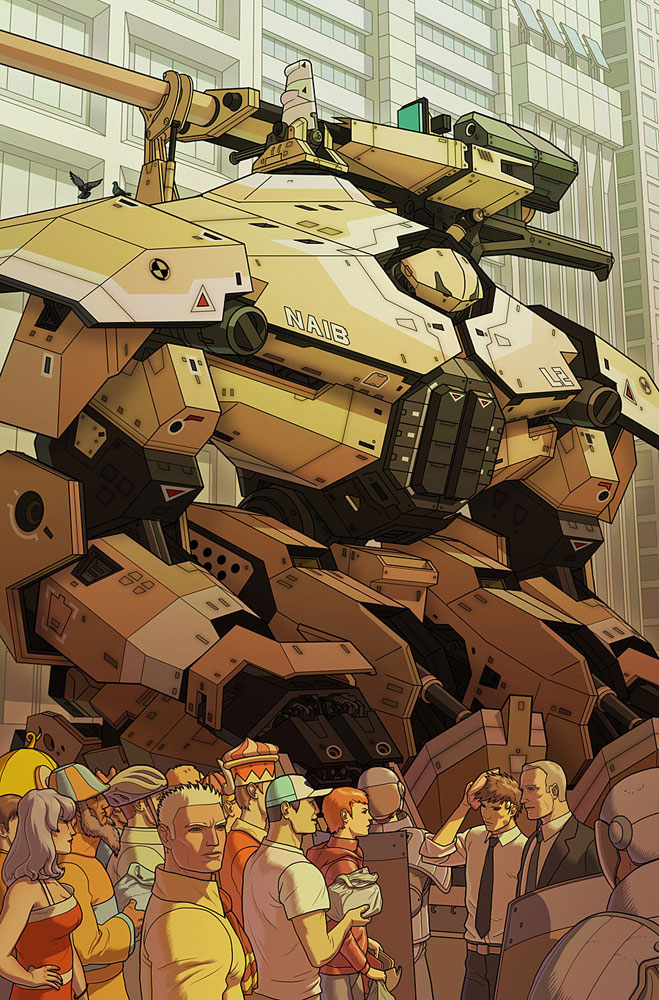
CB: I think this links back nicely to how you earlier said that you were “constipated” while trying to create. This looks like a great example of allowing your work to be dated to a specific set of interests and influences you are having during the process of the work; not to make work in a vacuum.
NS: Yeah, absolutely. Also, when people write AIs now, especially for movies, it’s always a monster. It’s always basically a mean human with some extra power. I feel like an honest depiction of a malevolent AI would be so much more deeply horrifying because it’s less like a human and more like a spider or something. I don’t even think it’d be capable of malevolence, specifically because I don’t think it’s going to care about us.
CB: Right, does our potentially limited palette of emotional or social queues even apply to an intelligence that is extremely not human in nature?
NS: I don’t even know if you get to use the work “nature” and that’s where it gets really interesting. We’ll find out if we’re even compatible in 20 to 30 years and I hope it works out for us.
I hope the AI likes Nonplayer. They very well may be the only things to read the final issue.
[Interviewer’s Note: I spend more time than is worth transcribing telling Nate about Jonathan Luna and Sarah Vaughn’s Alex + Ada – another fantastic Image title involving AI sentience.]
NS: You know, one thing I like about Eric [Stephenson] is that he really has the patience to let a book unfold, even if some books don’t perform that well in issue format, but once they’re collected they can be great.
CB: Yeah, having that be an option in a system that demands certain things upon stories based on a very tight schedule is nice.
NS: Woe betide the person who has a story that doesn’t fit neatly into the structures that are currently in place.
CB: And inside this structure, it looks like Nonplayer occupies this unique role of the Pariah almost, in certain circles of comics readership.
NS: It’s a target, for sure.
CB: Do you think with the changing climate of comics creation, would this sort of reaction happen again?
NS: I think people are looking at it and consciously or unconsciously, they’re recognizing that it’s economically stupid. Maybe we’re part of a culture that places a lot of emphasis on that, right? Why do we care so much about how much a movie makes on its opening weekend? How is that relevant to anything? I see how it’s relevant to the people who made it, but I don’t see how it should affect what I feel about the movie, but people like to crow over the dead bodies about a failed movie.
I feel there’s a similar impulse with Nonplayer where there’s a little bit of schadenfreude where people just like to see a ship go down. Yeah, I think some people decided that I was lazy; there’s definitely a narrative of laziness there, but I’ve never stopped working on it or maybe I don’t know what the definition of lazy is.
CB: It’s interesting how those narratives around creators get formed. I feel like it was different when it was only letters sections, conventions, and signings, but now everyone has a blog, mailing list, or twitter account to work with.
NS: That’s actually the one thing that saved my bacon; if my book came out in a vacuum – if it just hit the stands one day and no one had any idea who I was, I think it would have vanished immediately. There’s the narrative of the book, but there’s also the narrative of the creation of the book and if I’m being honest I think that most of the people who are supporting Nonplayer are, on some level, supporting the enterprise as much as they’re supporting the book itself. They understand how painful it was to make it and I find, in a lot of cases, that there are people with similar ambitions or projects who empathize with the difficulty of the project.
So, for everyone person who casually shits on the book in a comment thread on Newsarama, there are a lot of people out there who either read my blog or whatever that understand what it is that I’m trying to do and are much more forgiving.
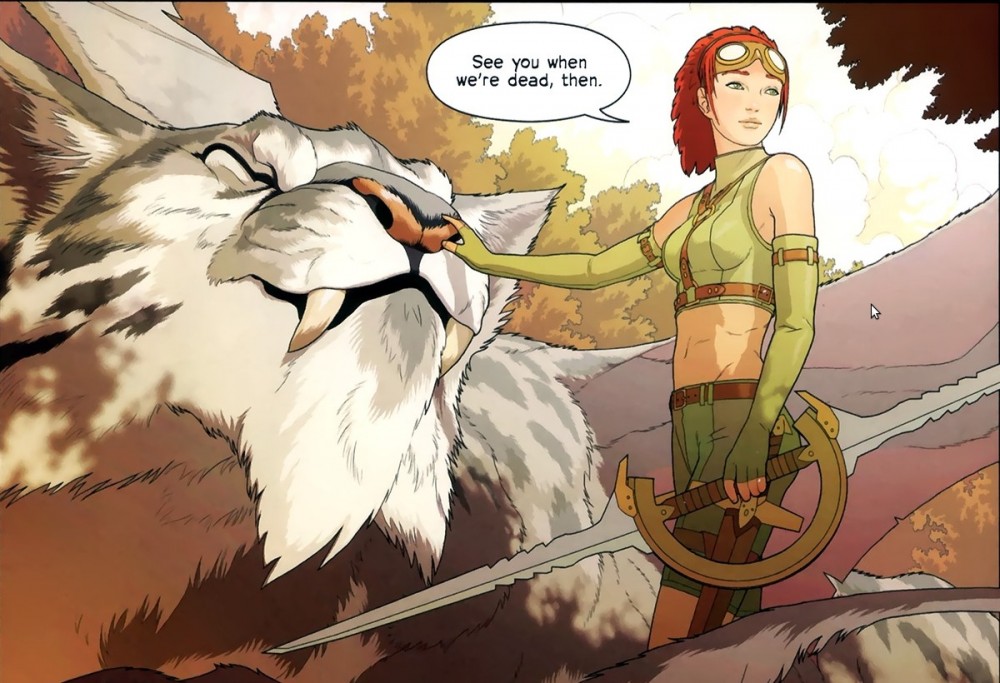
CB: Do you think we’re approaching an era more based around creative compassion?
NS: I hope we are! There is the existence of all these crowd-funding stuff so a lot of people keep coming to me to put Nonplayer on Kickstarter or Patreon since it’s not sustainable in the comics market. They ask me why I shouldn’t try to find a way for people to give me their money directly.
Well I have a little experience with Kickstarer through games; if there’s a target on me now, you cannot imagine the size of the target that would be on if I were running a Kickstarter. “Now look at this guy! This lazy ass is coming out, hat in hand, asking for your money directly.”
CB: Do you think that’s a good reason not to do one?
NS: I think it’s actually a bad reason not to do it, but I am definitely conscious of having a target on my back and to ignore that requires maybe more self-confidence than I personally have. Also I don’t know what it would be that I would offer through a Kickstarter – I already sell posters and whatnot. I’m not even sure that having a successful Kickstarter campaign would allow me to work on the book full-time anyway.
Either way, as weird a book as Nonplayer is, there’s no other place and no other time that it could have become a real comic. Eric…really rolled the dice on it.
CB: I’m curious how that happened, how did Nonplayer find its way to Image?
NS: Joe Keatinge. I was posting these pages to my blog that three people read and one day I sent a fan letter to Brandon Graham. I’ve always been a fan of his and sent him a link to some of the images on my blog to show what I was working on. He posted a couple of his images and the day after that Warren Ellis, who apparently read’s Graham’s blog, posted a couple images from it and all of a sudden I had three readers to 3,000 in a week. The internet really make this thing happen. I don’t really remember the whole mechanism, but then I began interacting more frequently with that group of Image creators including Brandon and Justin “Moritat” Norman. Joe was a part of that circle, he was working at Image and he was a big fan of the book and pitched it to Eric on multiple occasions and finally Eric said “well sure, let’s put it out.”
I’m certain he couldn’t have anticipated how long it would take me to get out the second issue, but he knew it wasn’t gonna be monthly. I’m sure he would prefer the book to come out a lot faster than it has because we have to climb a completely new promotional mountain for every one of these issues because there’s no momentum at all. But he stands by the book and he likes the book, I don’t know many other publishers who would be okay with that release cadence.
Even if Nonplayer is never successful financially, I think it’s successful because I’m proud of it. It could sell two copies and I’d still be proud of it.
CB: Yeah, Image is in a really unique gestating place where it’s trying out all kinds of new stuff and who knows where they’ll be in five years.
NS: I don’t know how true these things are because I didn’t hear them directly from the horse’s mouth, but some of the people who have been associated with some of the more recent big successes at Image like Saga or Shutter […] I’ve been hearing that they were “somewhat inspired” to do the projects that they decided to do because of Nonplayer. Obviously their books are coming out monthly so they’ve got something I don’t, but if it’s true, that’s very gratifying. Maybe it served that purpose; to shake something loose or open up a possibility just a little bit in a new direction.
I’ve talked to two or three pretty prominent female artists who weren’t active in 2011 or 2012 who are now a really big deal, and Nonplayer was very high on their list of things that got them excited about what comics could be.
CB: I find that a really great thing and sort of brings me to my last question that we didn’t touch on by accident. Many years from now, when you get your comps of the nice, assuming hardcover of the collected Nonplayer, do you have plans of what’s next?
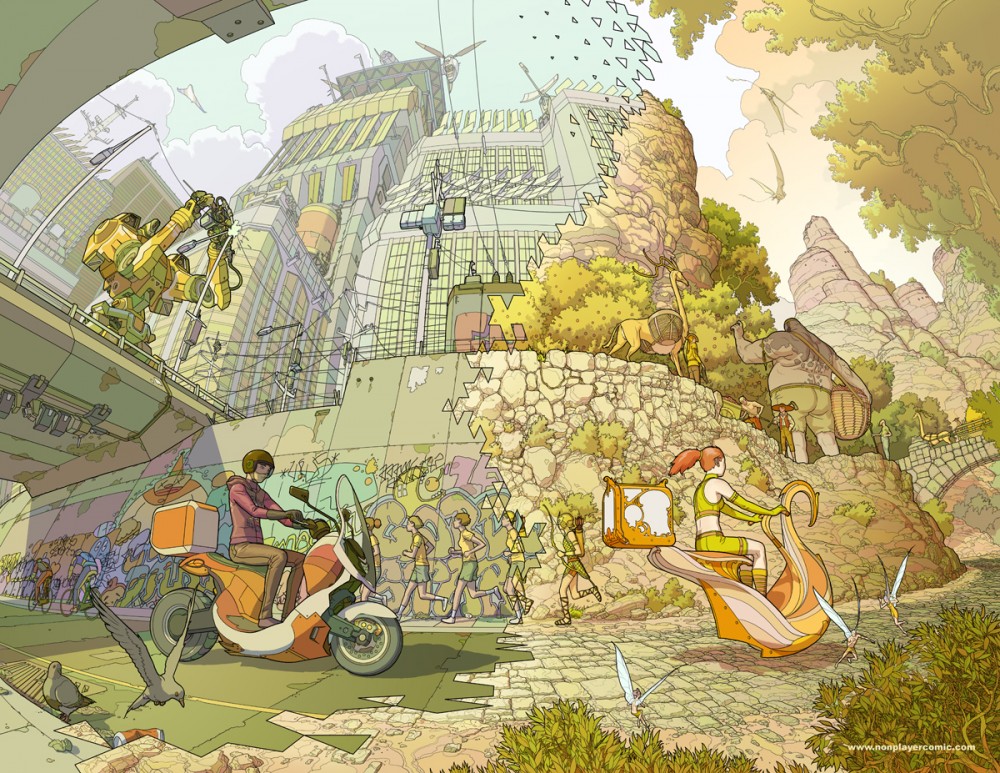
NS: What’s a good intersection to commit seppuku?
I have another project that I’m writing that I expect someone else to draw and I’m very excited about it. That’s another strategy I’m exploring to make it so I can work on comics full-time. If I’m a writer on a book, that takes up two days a week and I can spend four days a week on Nonplayer, which will speed that up immensely. The question, of course, is there any universe where writing a book and drawing another slow book brings in an amount of money similar to what you make in games? The answer’s probably no, but we’ll see.
CB: That’ll be an interesting test of faith to see if people who feel burned on Nonplayer will be willing to pick up a book you’re on.
NS: Yeah, I’d have to have multiple issues in the can before we even pull the trigger and it would have to be a bunch of proven artists, probably multiple artists similar to the way Brandon did Prophet. Many people predict retailer gloom and doom saying no retailer will ever trust me again and all that, but my personal experience has been the opposite. Retailers have really liked Nonplayer, it’s an easy hand sell and they just want more of it, so that’s a good problem to have.
CB: As readership changes, so do the shops, it seems.
NS: Yeah! I love where comic shops are headed. They’re not these back-alley, heavy metal places anymore. They’re getting a lot friendlier, especially to female readers. I may be benefiting on some level from the shift in demographics, my comic is a little more accessible than what was being made when it first came out – now everything’s so much broader. Frankly, Image has been the biggest beneficiary, just look at their market share, it’s crazy.
CB: Thank you very much for your time, Nate.
NS: Thank you.




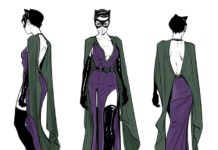
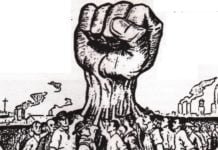
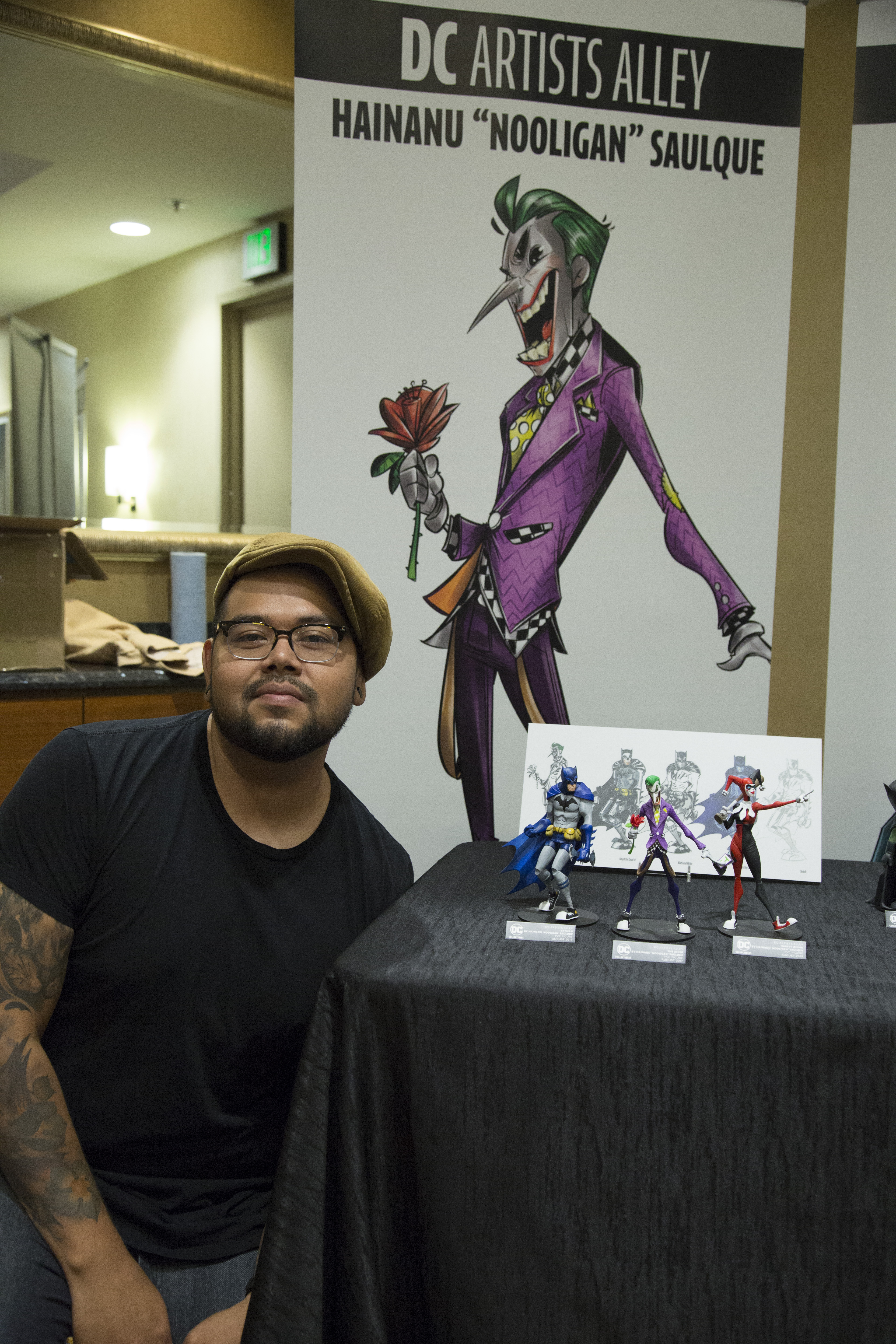



Comments are closed.